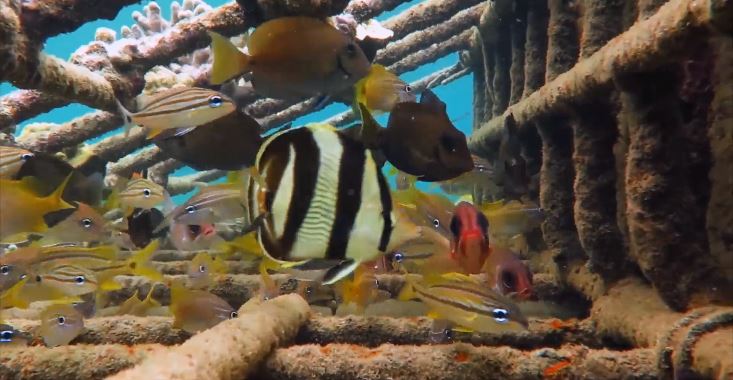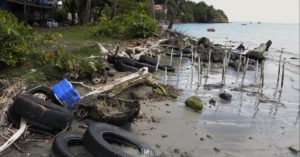A study by researchers at UC Santa Cruz and the Nature Conservancy working in Grenville Bay, Grenada, have now measured the protective role of coral reefs and field-tested a solution that reduces coastal risks by combining innovative engineering with restoration ecology.
Published February 1, 2018 in the Journal of Environmental Management, the study also evaluates one of the first uses of reef restoration as natural infrastructure specifically designed to reduce risks to people and property.
Investigating the link between healthy reefs and shoreline stability, the researchers found that Grenville’s healthy reefs keep more than half of the bay’s coastline intact by reducing the wave energy arriving on shore.
In contrast, severe reef degradation is linked with chronic coastal erosion in the northern section of the bay, where the shoreline is disappearing at a rate of almost two feet annually.
In their attempts to adapt, villagers built makeshift barriers with tires and driftwood to slow the erosion threatening their homes, but these efforts have been largely unsuccessful. The reef restoration project was designed to enhance both the ecological functions of natural reef habitat and its protective effects.
An innovative coral reef restoration project is called At the Water’s Edge (AWE) was the focus of the research. AWE is a community-based initiative led by the Nature Conservancy to increase coastal resilience to climate change.
They created a reef-based breakwater structure (pictured at top) that’s a rare example of reef restoration designed to increase community resilience and decrease vulnerability. The aim is to facilitate the recovery of the coral reef while reducing coastal erosion and flooding.
The reef restoration structure is made from inexpensive and locally-sourced materials by local labor. It’s easy to assemble on-site, and is suitable for high wave energy or hurricane exposure. It’s specifically designed to facilitate marine habitat restoration.
Live coral fragments from the existing reef were placed onto the structure to encourage natural reef growth. This approach is designed to be replicated in small island communities, which are often the most susceptible to the impacts of climate change.
The goal of At the Water’s Edge is to work alongside the governments and communities of small island states to enhance their resilience to climate change by protecting, restoring, and managing marine and coastal ecosystems and strengthening local capacity for adaptation.
Across the islands of the Eastern Caribbean, climate change already places intense pressure on human livelihoods and coastal and marine resources. Small islands states contribute very little to global climate change in terms of greenhouse gas emissions. Yet, these nations are the most vulnerable to the impacts from climate change due to their high coastal population densities, limited land space, geographic isolation, scarce freshwater supplies, and significant dependence on tourism and fisheries. These islands now face significant threats from increases in severe storm events, flooding, coastal erosion, drought, saltwater intrusion of coastal aquifers, and bleaching of coral reefs.
Island nations currently use a range of engineered solutions to respond to climate change, (e.g. constructing sea walls, levees, dams and river bank hardening). Although traditional infrastructure is sometimes necessary, it is costly and often destroys natural systems that island residents rely upon for basic services and quality of life, such as food, coastal protection, recreation, water security, and livelihoods.
In the Eastern Caribbean, we have worked with the government and people of Grenada and St. Vincent and the Grenadines for more than a decade, helping strengthen national parks and protected area systems and developing sustainable finance and human capacity for effective environmental management. The At the Water’s Edge (AWE) project builds on these experiences and partnerships to develop, test, and implement ecosystem-based adaptation (EBA) strategies which enhance communities’ resilience, while protecting natural environments.
Photos courtesy of The Nature Conservancy.


